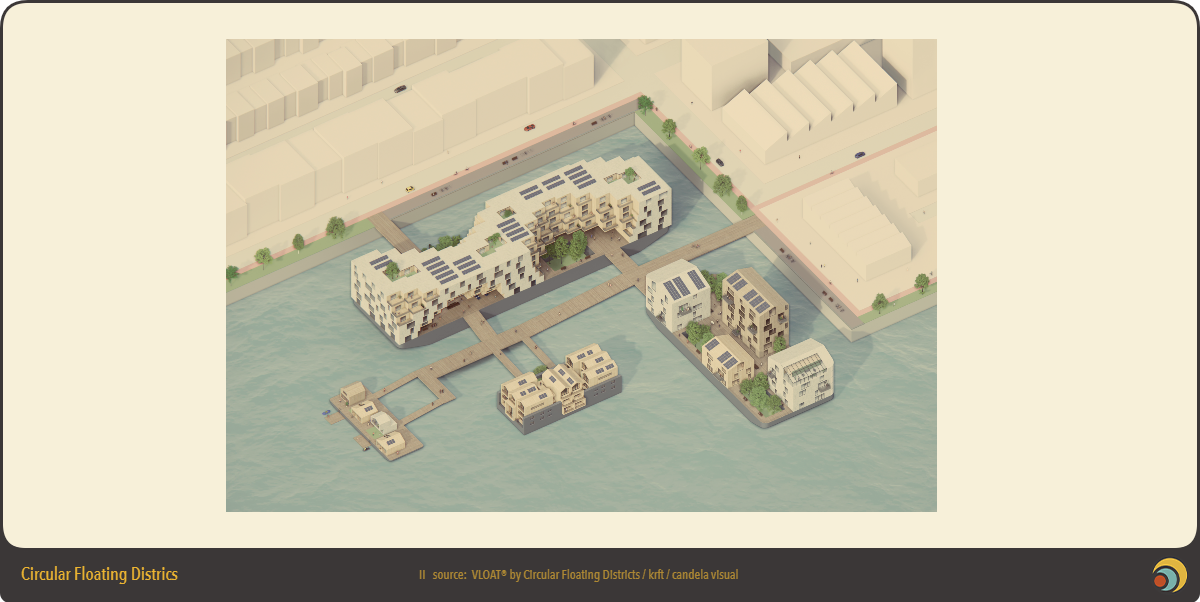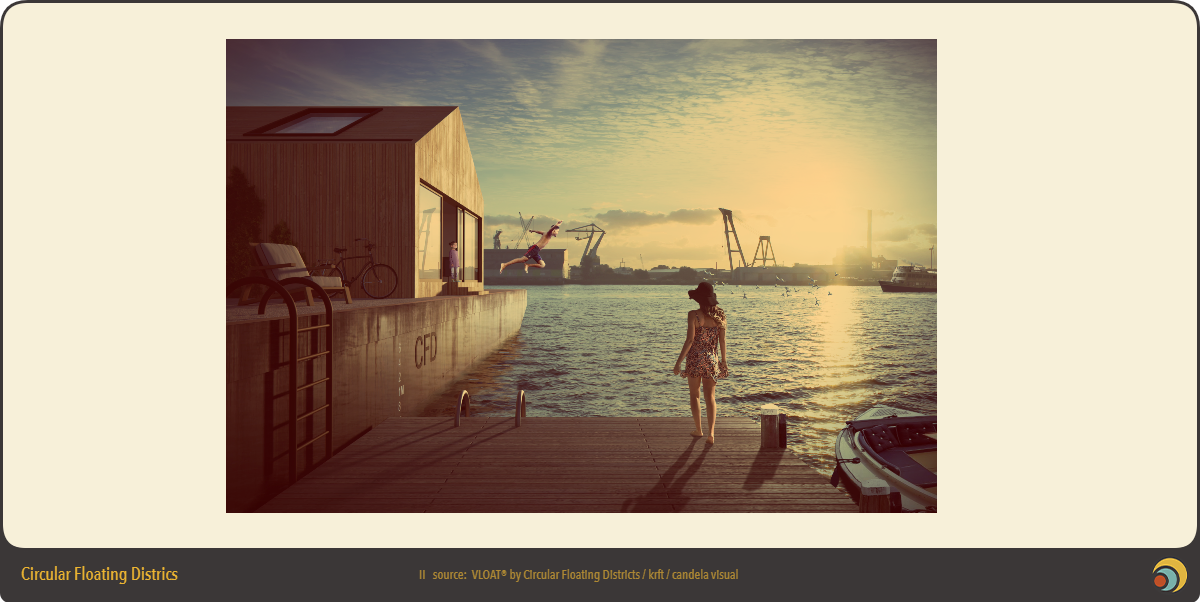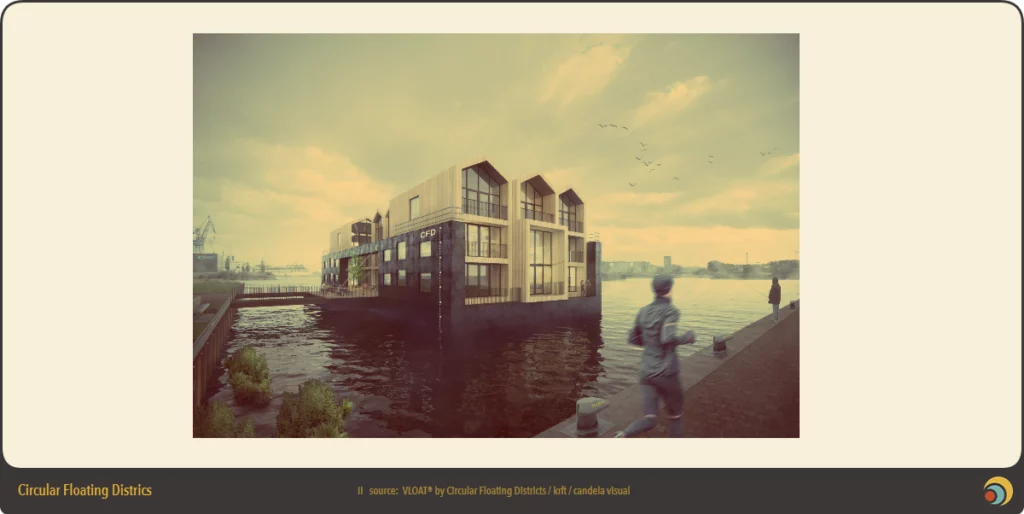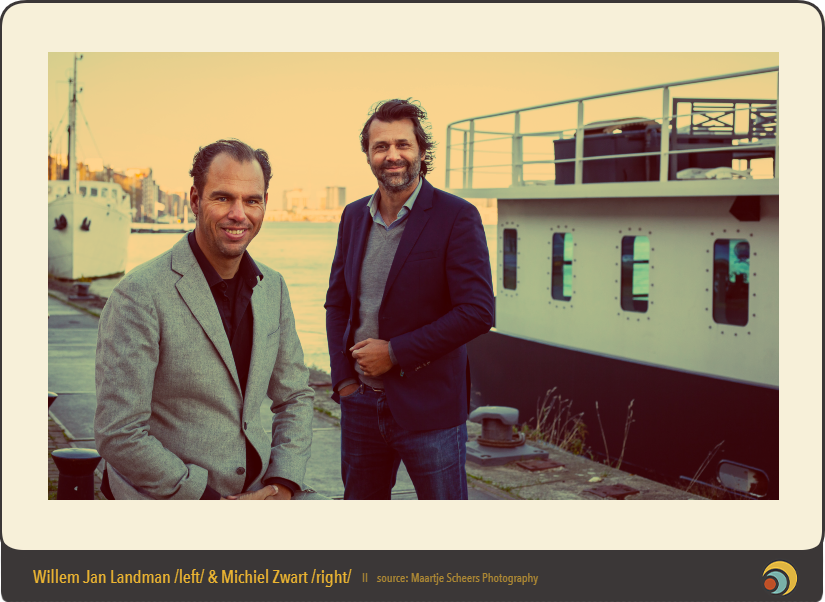This month, we talked to Willem Jan Landman, a Dutch “sailing architect” working on turning used barges into floating, sustainable neighbourhoods. He explained to us how their first concept “VLOAT” is circular, what purposes they can serve and how they can be integrated into urban networks.
BURST: What is the work you are doing?
Williem Jan landman: I founded our concept development company “Circular Floating Districts” with Michiel Zwart. I’m 43 and previously, I have worked as an architect for several Dutch architecture firms, mostly on sustainable private villas. In 2018, I started my own company Willand, where I focus on concept development and business development, helping young architecture firms with new clients. Besides that, I started to develop the concept of circular floating districts.

Beyond my work as an architect, I’m a professional sailor and I run a foundation called Holland Ocean Racing. We educate young international sailors. I’ve actually just come back from skippering our Volvo Ocean Racer in the Baltic Sea.
Could you please explain what a circular floating district is?
The idea behind “VLOAT”, our first concept of circular floating districts came when I was out sailing in 2015. We passed by a huge barge used by the oil industry, 260 m in length, 63 m in width, and 8 metres above the water, and there was nothing on top. So I thought “why don’t we build something on top of it”. In 2016, I approached Michiel who is my partner in Circular Floating Districts, as he is a naval architect. So we started with these second-hand barges that we will buy from the market. We could use them to build floating houses, schools, hotels, and retail – we realised, everything is possible. We started developing a concept around this, and came up with the idea of circular floating districts, creating new districts in port cities where there is enough space on the sea for barges. KRFT Architects from Amsterdam support us with designing the buildings. We have several other partners, for example, our international operating legal partner Allen & Overy.
Barges differ in size: we have the North Sea pontoon, which is up to 260 metres in size, there are up to 90-metre barges, then there are dry docks, used for maintenance which have steel walls, these can be flooded and then the dry dock will sink and ships can be maintained. We use 80 by 43-metre former dry docks. Finally, we use river barges that could be used inlands. It would be possible, for example, to put them in Budapest along the river bank.
How will “VLOAT” circular floating districts look like?
We made a flexible concept, ranging from barges with 4 single-family houses, to dry docks with a maximum of 22 houses, while the residential urban block has up to 188 flats. So some would fit in a city of the size of London or Amsterdam, and some others could be integrated into smaller cities. We also put green areas on the barges. They are sometimes up to 8 metres in depth, which allows us to plant trees.

Schools and other public buildings can also be potentially put on barges, and so can retail space. If we think of a larger district, that should be a vibrant area where you can go shopping, and go to the bar. You can use these solutions in a large scale, to create larger districts, but also on a smaller scale, creating smaller neighbourhoods.
The floating districts will be circular, which means we will use circular or renewable materials. For example, we use cross-laminated timber. If a building is temporary, we can take them apart and use them for other buildings.
We are also conscious of reducing our land use. It will be pre-fabricated and assembled in a shipyard, so we will not take up urban space for the construction. This of course is why houses can be reused.
What solutions did you come up with for other utilities, like drinking water or sewage?
Our aim is to be off the grid, we use solar energy but also the temperature of the water for cooling and heating through heat pumps. However, it depends on the country where we work and the local government regulations. In the Netherlands, we need to be connected to the shore and cannot be fully off the grid, as that is not permitted by law. However, we can use sea water through desalination to make drinking water, just as we do in offshore sailing. We use septic tanks for wastewater, but also, we treat grey water with nature-based solutions that can be reused to flush toilets or even dishwashing. We also have water tanks inside the barges. So we reuse water, we use solar power, heat pumps.
We have technical advisors working with us, who have experience in designing off-grid water villas. My architectural background is also in these topics of sustainable smart building design.
What are people most interested in regarding floating districts? Do they see this as a solution to rising sea levels, or as a way to extend cities over water, to create new cities, etc.?
It can of course help with rising sea levels. Much of the Netherlands and Amsterdam will be flooded, which makes flexibility also interesting. Several countries with low-lying areas are interested. For example, we negotiate with Poland on creating a sustainable floating district there. We are invited to sustainability weeks in Poland, Lille, and New York.
Can you imagine making a circular floating district completely offshore?
Our concept is made for cities, we call it “island living in the city”, creating islands where you can enjoy the benefits of island life (such as those in the north of the Netherlands), which can serve as quiet, not very intense areas. So we are focusing on integrating these into existing cities.

Some other companies work on completely offshore solutions, but then you need other floating devices and these North Sea barges are not suitable for being completely offshore. For that, you need concrete cases and higher artificial islands because of waves. And you need to make sure how you will go there: by boat or by (hopefully electric or hydrogen) plane.
Is there a limit to how much you can expand your city over water?
Yes, but that doesn’t yet bother us too much. In the Netherlands, many cities are still working on turning water areas into new land, which our country is quite famous for. However, you can also create new water lagoons instead of removing them. We see a lot of potential to launch the project. In the Netherlands alone, we believe we can create a huge part of the 900 thousand dwellings which we need to build to solve the housing crisis.
Do you work on any concrete projects right now?
We already have a number of ongoing projects. We have 3 smaller projects using river barges, but we are also in negotiations with a shipyard to prototype one of the larger barges.

We also cooperate with Plastic Whale Foundation, a Dutch organisation fishing Amsterdam canals for plastic bottles and reusing them. They want to use plastic bottles as construction material as well. We teamed up with them to create an educational concept on floating districts and circular use of materials. We will also use urban mining – existing materials from demolitions – in this project. This will be launched in the next year.

Willem Jan Landman is a #Dutch architect owning his own firm, Willand. Previously, he worked for other companies on private houses. Together with Michiel Zwart, he initiated the circular floating districts concept and works to deliver circular floating districts throughout Europe.
